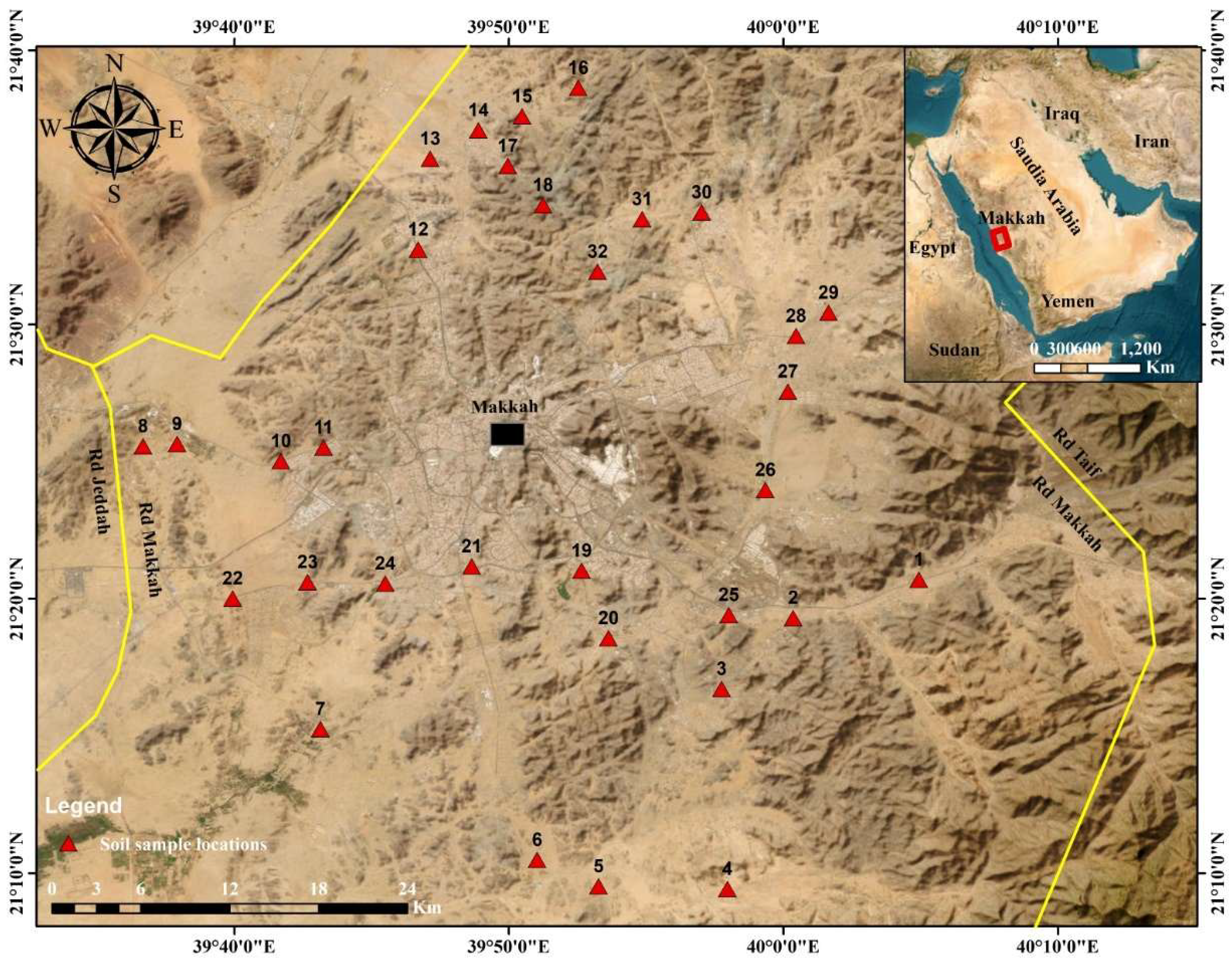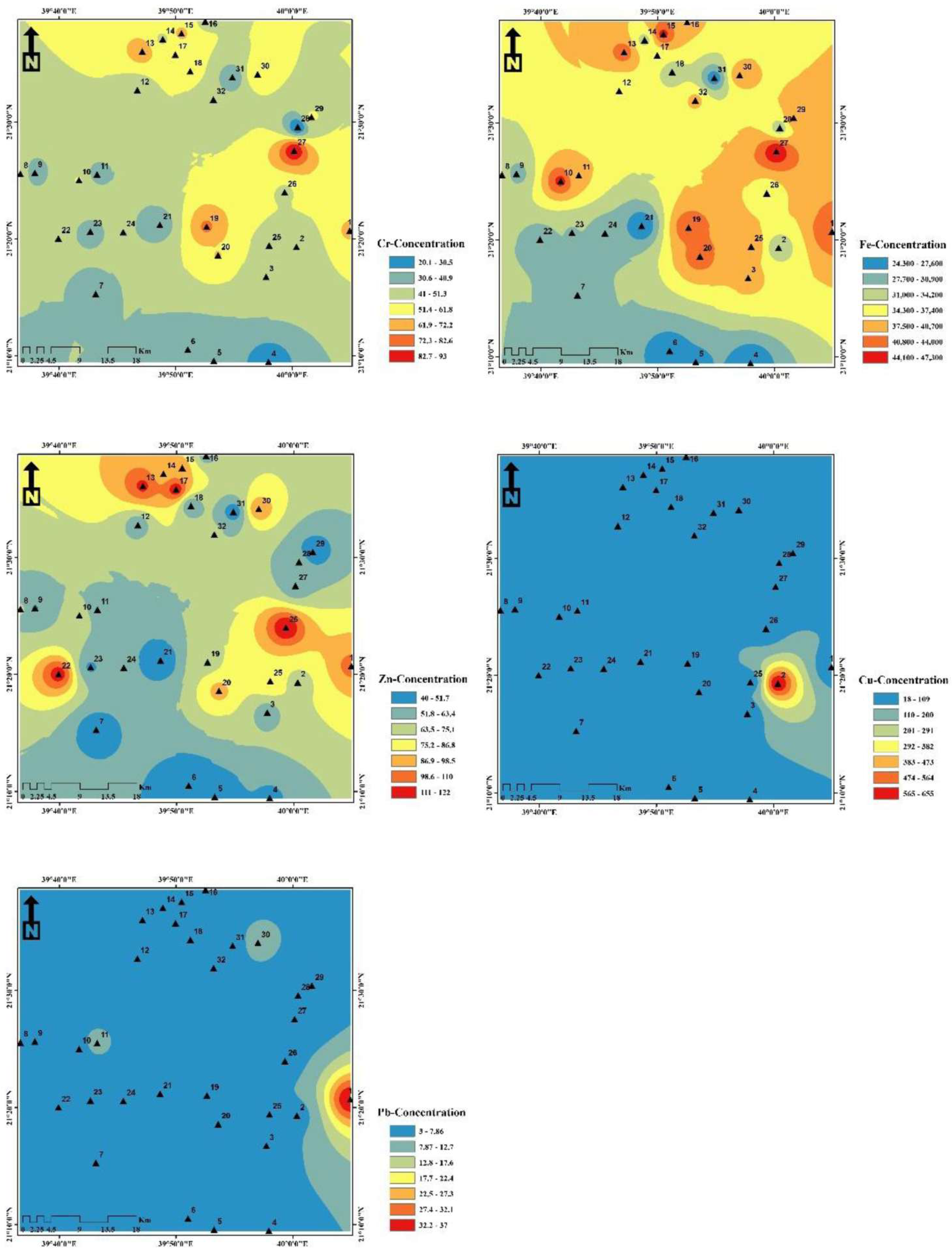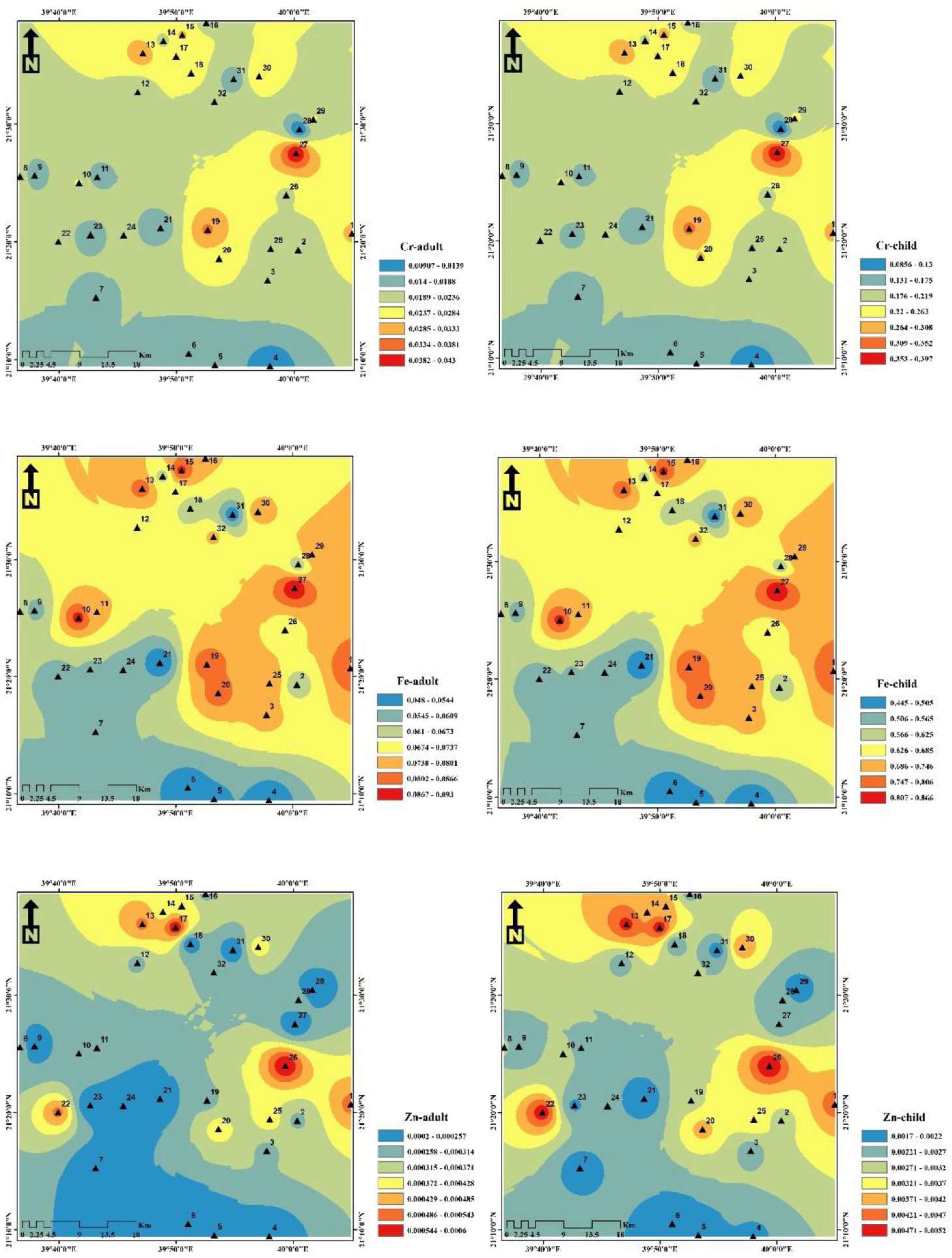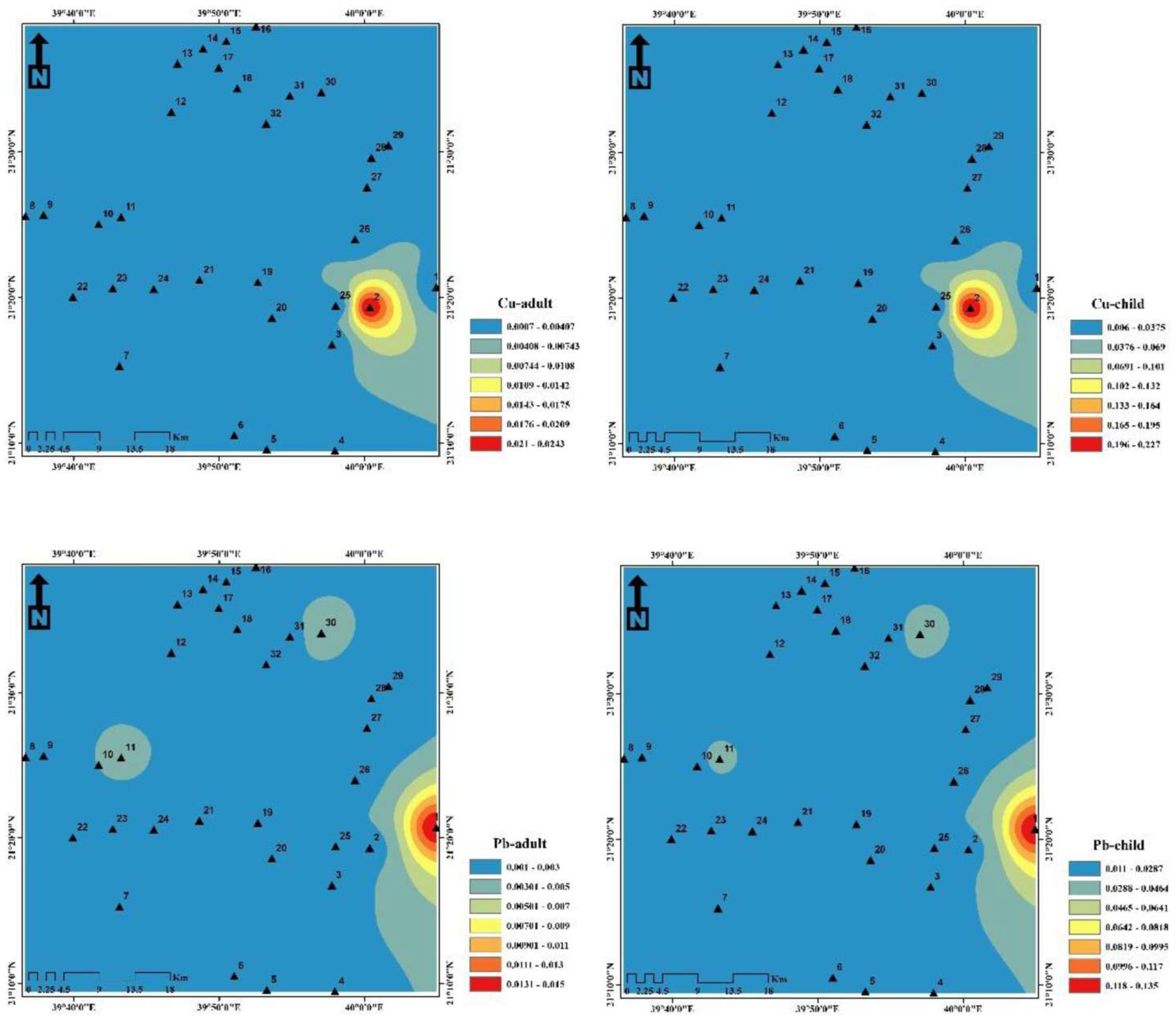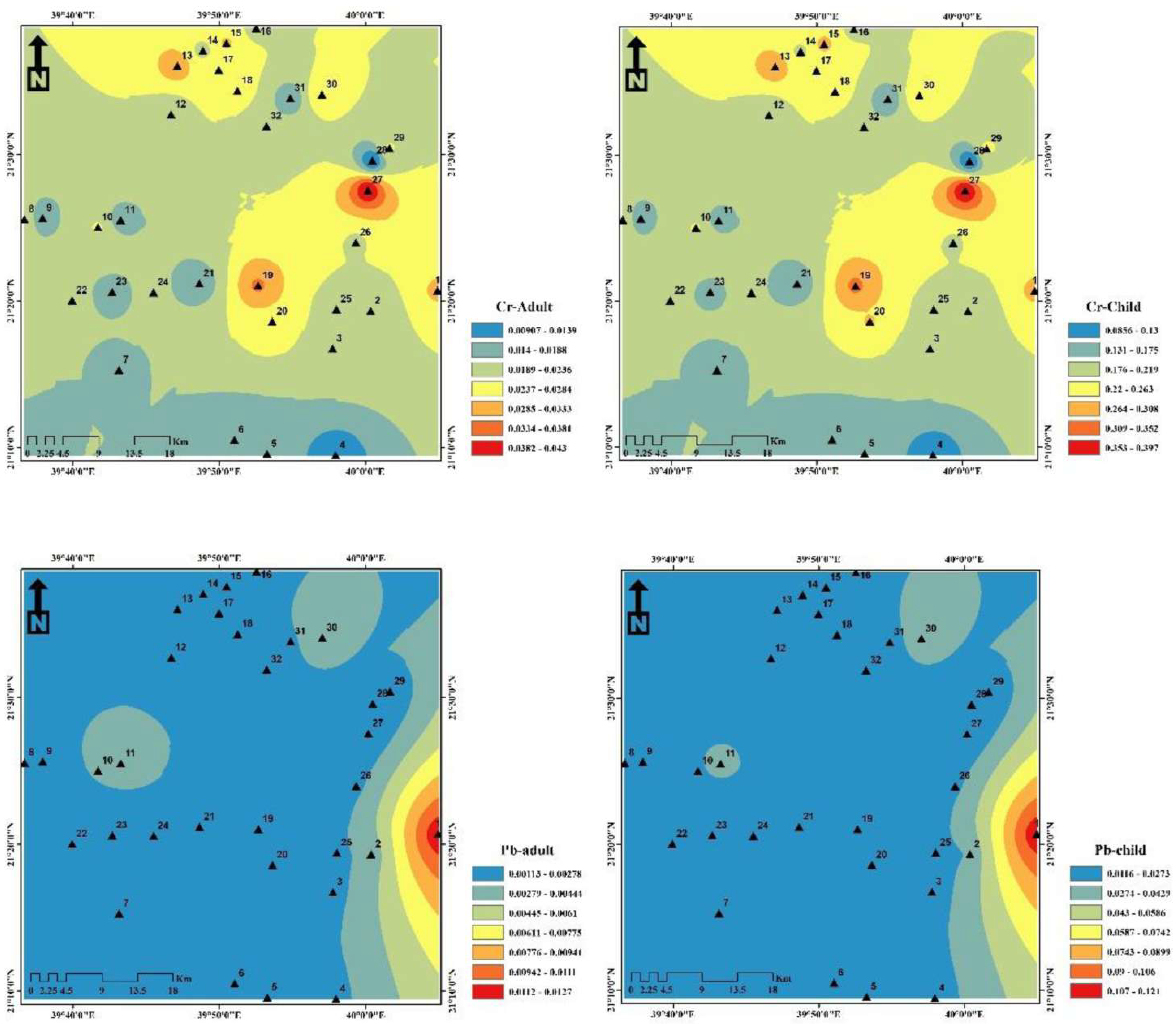1. Introduction
The presence of harmful heavy metals (HHMs) in soil is a major issue in developing nations since it has enduring health consequences. Human activities have caused metal concentrations to grow in several environmental media [
1,
2]. Anthropogenic activities are the main contributors to localized pollution, including abandoned industrial sites, poor waste disposal, unregulated landfills, excessive use of agrochemicals, spills, and similar accidents. Unregulated mining and smelting practices are a significant cause of HM contamination in many locations throughout the world [
3,
4,
5].
In addition, the presence of aromatic hydrocarbons and toxic metals, which are often found in oil products, contributes to the occurrence of localized pollution [
6,
7]. Soils in close proximity to roads often show elevated concentrations of HHMs, polycyclic aromatic hydrocarbons, and other contaminants [
8,
9,
10]. Specific crucial trace elements such as Co, Cu, F, Mn, Mo, Ni, and Zn are essential in small amounts for diverse biological processes. Nevertheless, an overabundance of these vital HHMs might have detrimental effects on plant growth, potentially compromising the integrity and functionality of cellular structures [
11,
12]. In contrast, non-essential metals such as Pb, Cd, Hg, As, Cr, Ag, and Sb are harmful to both eukaryotic and prokaryotic life. The excessive accumulation of HHMs in the environment frequently results in substantial pollution of soil and water, giving rise to considerable worldwide environmental issues [
13,
14].
The western region of Saudi Arabia is distinguished by a multitude of Wadis, which are created by the runoff of transitory streams that originate in the mountains of the Arabian Shield and flow towards the Red Sea. The alluvial deposits found in these Wadi channels are crucial for providing a local source of groundwater [
15,
16]. The studied region is mostly defined by Torriorthents soil, which is a type of Entisols. This soil is primarily found in residuum or colluvium on slopes that are actively eroding, as well as in materials that are resistant to weathering. The soils in question are often shallow and consist of several types of soil, such as loamy sand, fine sandy loam, sandy loam, loam, or clay loam. Additionally, there are also gravelly variations in these soils [
17,
18].
Geographic Information Systems (GIS) (ArcGIS 10.8, QGIS 3.28) and multivariate statistical analysis are essential tools for evaluating the health and environmental risks posed by heavy metals (HMs) in agricultural soils. To determine possible HM sources, differentiate between anthropogenic and natural contributions, and find temporal and spatial trends in contamination levels, multivariate techniques like Principal Component Analysis (PCA), Cluster Analysis (CA), and correlation analysis are frequently employed [
19]. By breaking down complicated statistics into digestible insights, these techniques can identify important pollutants for additional research and help comprehend the correlations between variables. By combining environmental, health, and socioeconomic data for thorough risk evaluations, mapping risk zones, and spatially displaying pollution patterns, GIS enhances these analyses [
20]. Researchers can evaluate exposure pathways, estimate pollutant dispersion, and forecast possible effects on ecosystems and human health by combining GIS with multivariate methods. When combined, these techniques offer a strong foundation for focused mitigation plans and evidence-based policymaking to protect public health and agricultural output [
21].
Makkah city is situated in the southwestern region of the Al Hijaz province within the Kingdom of Saudi Arabia. The area lies between the flat coastal plain (Tihamat Al Hijaz) and the steep slopes of the Sarawat mountains, which were formed by tectonic activity associated with the splitting of the Red Sea [
22]. The Wadis of Makkah exhibit intricate and interconnected patterns as they traverse the mountain ranges, a characteristic feature of dry landscapes. These intersecting alluvial zones provide valuable insights into the morphotectonic evolution of the region. Geologically, Makkah is underlain by late Proterozoic volcanic and volcaniclastic rocks of the Arabian Shield, which include the Milh complex, Ju’Ranah complex, Zibarah group, Samaran group, and Fatima group [
23]. These rocks have undergone multiple phases of deformation, metamorphism, and igneous intrusion. Additionally, the geological makeup encompasses Tertiary formations such as the Shumaysi, Sita, and Khulays Formations, along with Quaternary deposits including talus, fluvial, alluvial, and sabkha sediments [
24].
Due to its volcanic and volcaniclastic origins, Makkah’s geological makeup contains naturally elevated concentrations of heavy metals like Fe, Cr, Zn, Cu, and Pb [
25,
26]. In addition, tectonic activity associated with the Red Sea rifting has caused multiple deformation phases and igneous intrusions, which have likely contributed to geochemical anomalies in the area [
27]. Prolonged weathering and erosion of these rocks release trace metals into the surrounding environment, particularly into the Wadi systems that traverse the region. The region’s farming activities, predominantly in Wadi systems, rely heavily on soil and water resources influenced by natural processes and anthropogenic activities. The combination of the area’s complex geological background and its use for agriculture raises the potential for HM accumulation in the soil, either from natural geological sources or human-induced factors.
Understanding the extent of HM contamination in this area is critical for assessing environmental and health risks, ensuring sustainable agricultural practices, and protecting food safety in a region where agriculture plays a vital role. Multiple research studies conducted in Saudi Arabia have focused on analyzing the levels of soil contamination, identifying the sources of contamination, and assessing the overall pollution status [
28]. However, these studies lacked knowledge of metal mobility and bioavailability and solely relied on the total concentration of HHMs in the soil samples, ignoring geographical variability. Methods like as factor analysis, Cluster Analysis, and Principal Component Analysis (PCA) can be used to determine and differentiate between anthropogenic and geogenic origins of HHMs [
14]. Correlations between metal concentrations and particular environmental or human activities are also disclosed by these analyses. Spatial patterns of metal distribution can be visualized by combining GIS mapping with geostatistical techniques. This can draw attention to pathways and hotspots for pollution in the Wadi systems [
29,
30]. Furthermore, it is possible to quantify contamination levels in relation to background concentrations and evaluate ecological risk by utilizing indices like the enrichment factor (EF), geoaccumulation index (Igeo), and risk index (RI) [
31].
This study aims to (i) assess the concentrations of Fe, Zn, Cr, Pb, and Cu in agricultural soils, emphasizing the broader implications of HHM contamination for global food security and sustainable agricultural practices; (ii) evaluate the potential environmental hazards posed by these HHMs, highlighting their contribution to transboundary environmental challenges and the global ecosystem; and (iii) examine the health risks associated with HHMs in soil, considering ingestion, dermal contact, and inhalation pathways, while underlining the universal relevance of soil contamination to public health and its impact on global populations, particularly vulnerable groups such as children. This evaluation emphasizes the interconnectedness of environmental and public health risks in a globalized world, where contamination in one region can affect international food trade, biodiversity, and collective human well-being.
4. Discussion
The findings of this study provide insight into the spatial distribution and potential sources of HHMs in the soil of Makkah. While the average concentrations of Cr, Zn, and Fe were below the global average, localized samples demonstrated elevated levels, suggesting a mix of geogenic and anthropogenic influences [
46,
47]. The significant contamination of Cu in sample 2 aligns with mixed geogenic enrichment and agricultural practices [
27]. Similarly, elevated levels of Zn and Pb in specific samples could be attributed to the use of fertilizers and natural enrichment from the weathering of basement rocks in the study area [
25,
26].
The correlation matrix supports the notion that Cr and Fe may share common geogenic origins, as evidenced by their strong positive correlation [
46]. Iron and chromium are commonly associated with Proterozoic rocks, particularly ultramafic and mafic formations such as those in the Arabian Shield beneath Makkah. These rock types’ naturally occurring iron oxides and Cr-bearing minerals (such as chromite) decompose and release Cr and Fe into the surrounding soil. Minerals that are rich in Cr and Fe weather naturally over time, releasing these metals into soils and sediments simultaneously. This geogenic mechanism can account for the observed high positive correlation. The moderate correlation between Cr and Zn hints at contamination from overlapping sources, such as fertilizers [
47]. Zinc is commonly added to agricultural fertilizers to encourage plant development, even though some phosphate-based fertilizers may have Cr contamination as an impurity. The simultaneous application of both nutrients in agricultural soils may result in a modest relationship between Cr and Zn. Even though geogenic processes predominate in the distribution of Cr, it is also possible that Zn comes from natural sources, such as the weathering of Zn-containing minerals, which could account for the apparent link. However, the weak correlations of Pb and Cu with other metals suggest distinct and localized origins, potentially from industrial or consumer products containing these metals [
47]. Pb has a limited association with other metals, which highlights its dispersed distribution and specific sources of pollution, like garbage dumping and agricultural practices. Furthermore, Cu comes from anthropogenic rather than geogenic origins, as seen by its weak association with other metals.
Principal Component Analysis (PCA) reinforces these findings, with PC1 reflecting geogenic factors influencing Cr, Fe, Pb, and Zn, and PC2, highlighting the anthropogenic impact on Cu levels [
49]. The differentiation of Pb in PC3 underscores specific localized sources, potentially linked to agricultural or residential activities [
51]. The natural weathering of Proterozoic rocks, which raises the amounts of Cr and Fe, is one of the geogenic variables that PC1 captures. Because Pb and Zn are naturally enriched in the nearby bedrock, their existence in this component indicates a partial geogenic contribution. The impact of human activity on Cu concentrations is shown in PC2. The main causes of Cu pollution are industrial processes, agricultural uses, and the application of insecticides containing copper. The Cu separation into PC2 indicates that it comes from a different source than the geogenic metals in PC1. PC3 emphasizes the localized sources of lead, which might be caused by past or ongoing human actions, like the usage of lead-based products in certain places. The Pb separation into a distinct component is consistent with its poor association with other metals and emphasizes the significance of locating the sources of contamination locally [
52,
53].
The health risk assessment underscores that children are more vulnerable to the adverse effects of HHMs due to their behavioral patterns and physiological differences [
57,
59]. While the HI values for all metals remained below the threshold of concern, the elevated HI and LCR values for Cr in children suggest a need for targeted interventions in specific hotspots [
60]. This aligns with findings from previous studies emphasizing children’s susceptibility to heavy metal exposure [
61,
63]. Despite the tolerable levels of carcinogenic and non-carcinogenic risks, continuous monitoring and risk mitigation strategies are essential to minimize potential health impacts, particularly in areas where anthropogenic activities contribute to elevated metal concentrations [
63]. Future research should explore the long-term effects of such exposures and develop sustainable management practices to limit human and environmental risks.
5. Conclusions
The present work highlighted the existence of Fe, Cr, Zn, Cu, and Pb and their potential environmental and health hazards in agricultural soil in Makkah, western Saudi Arabia. The average HM concentrations had the order of Fe ˃ Zn ˃ Cu ˃ Cr ˃ Pb. The contamination indices revealed that the tested soil had either little or minimal accumulation, low pollution, and a low level of risk associated with HHMs. However, several individual samples showed higher values. The Proterozoic rocks on the Arabian Shield, which have high concentrations because of their volcanic and volcaniclastic origins, are the main source of the HM concentrations in Makkah’s soil, according to PCA. HM concentrations in surrounding soil and Wadi sediments may increase as a result of these rocks’ weathering and erosion. Furthermore, because Cu-based fertilizers, fungicides, and pesticides are commonly employed, agricultural practices may be connected to Cu contamination in particular regions. The order of HM concentrations in adults and children, based on their HI values, was as follows: Fe > Cr > Pb > Cu > Zn. The HI values for HMs in Makkah soil were below 1.0, indicating the absence of significant non-carcinogenic risk. The lifetime cancer risk values (LCR) for Pb were below 1 × 10−6, while for Cr they ranged from 1 × 10−6 to 1 × 10−4, which suggests that the level of carcinogenic risk is within an acceptable range.
